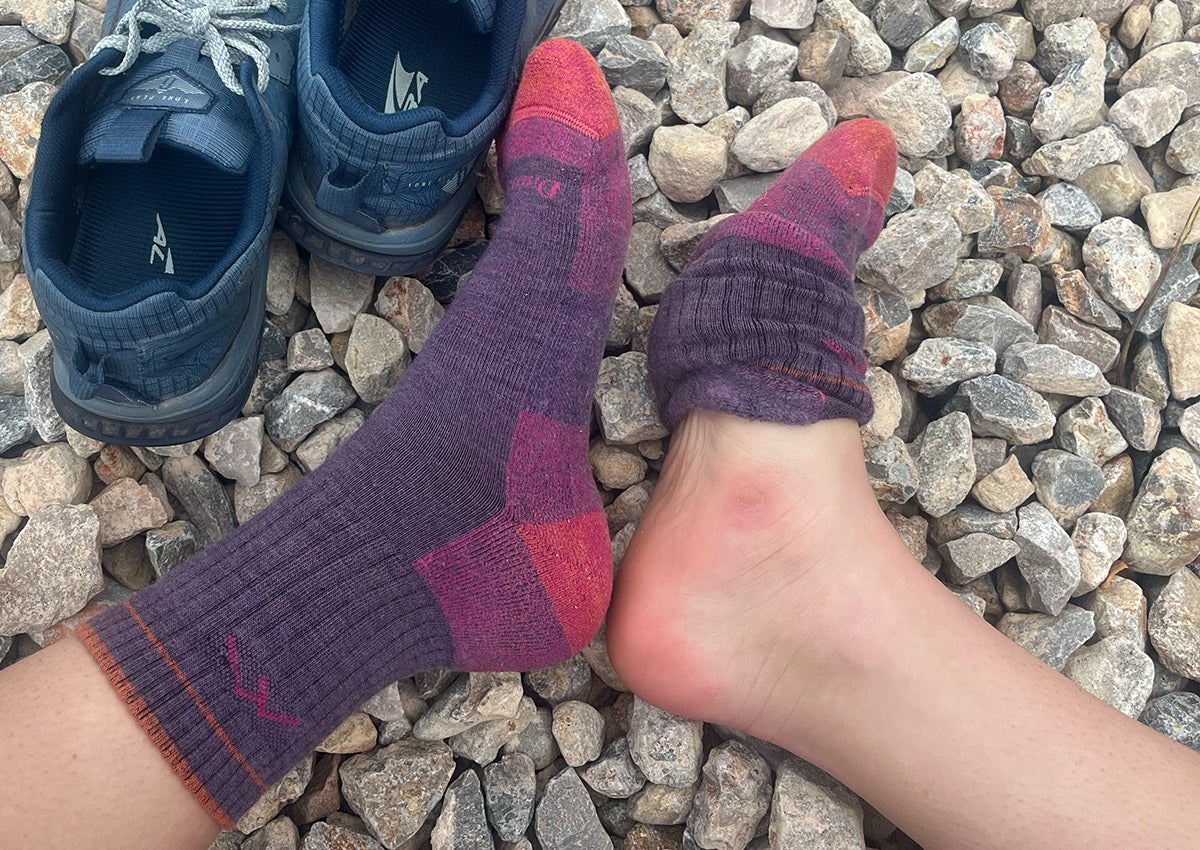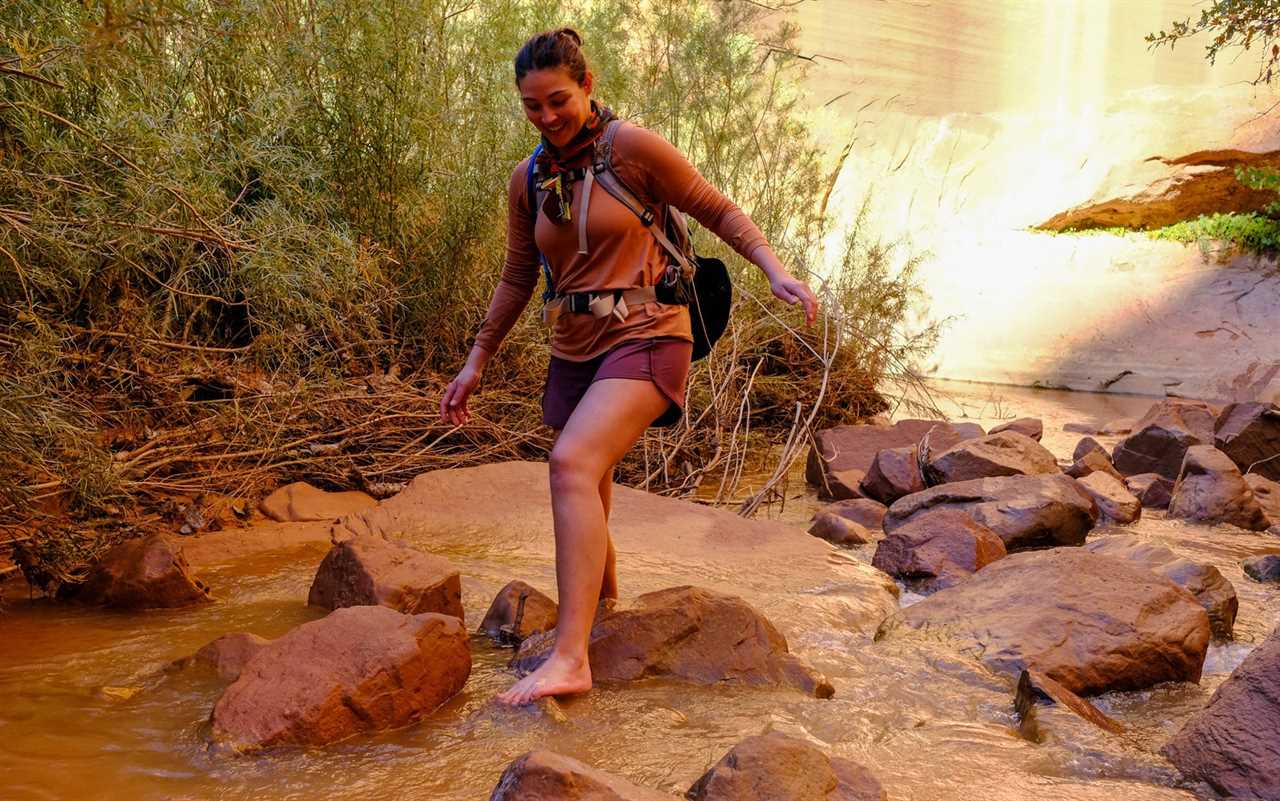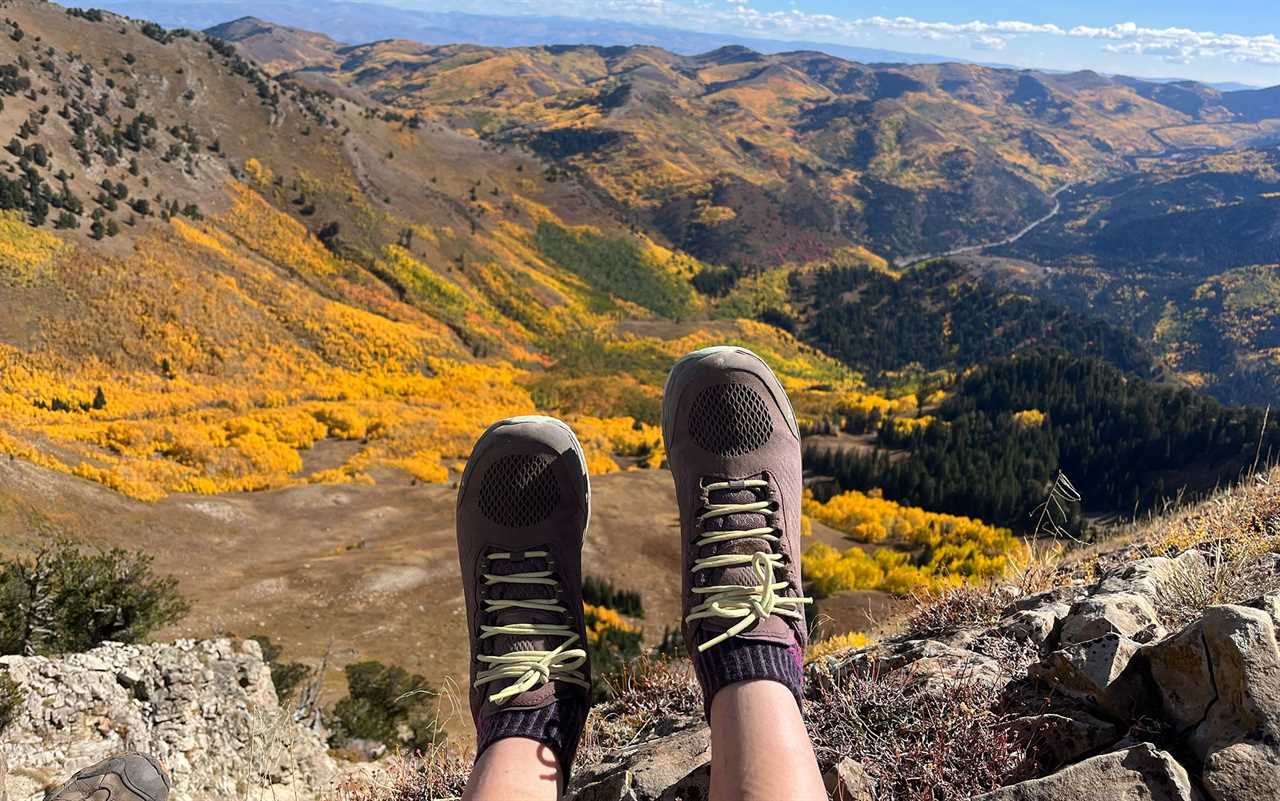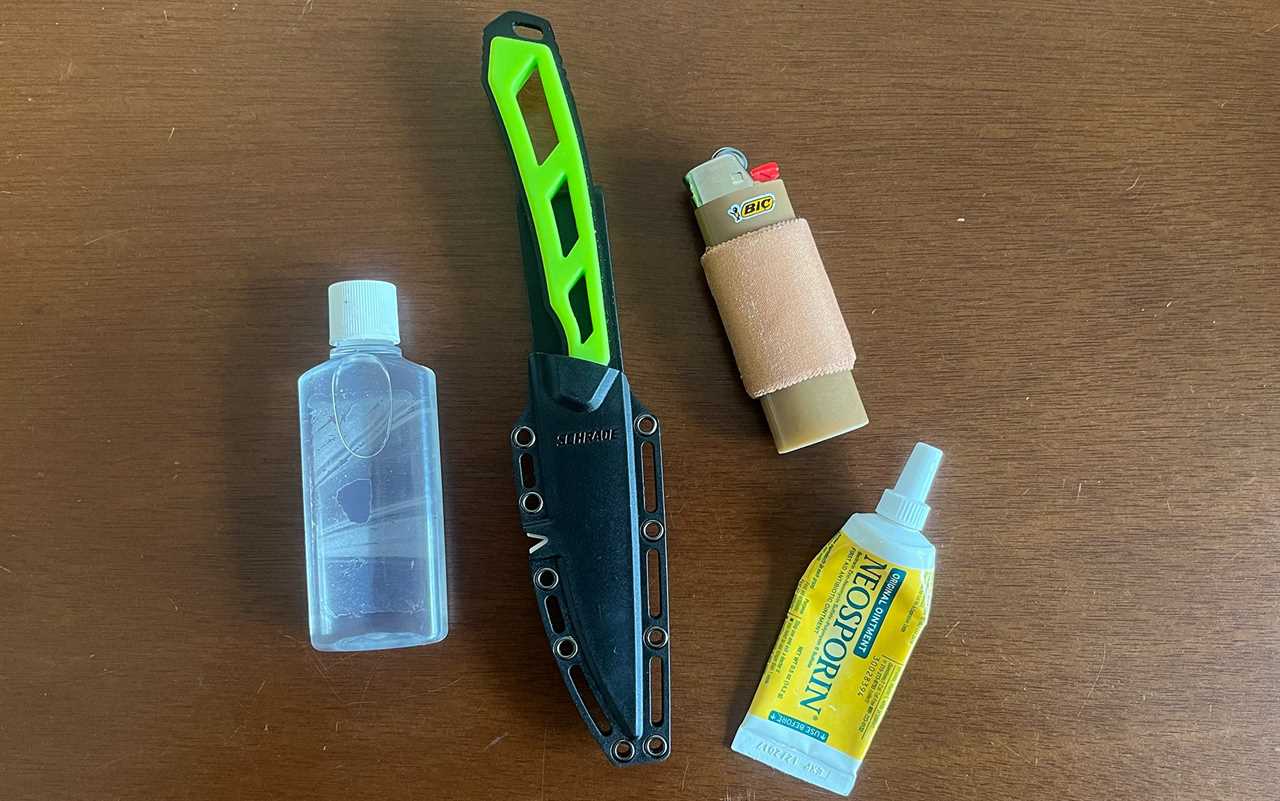Blisters can set you back miles or even end a trip, and they don’t go away after your first shower back in civilization. Hikers frequently debate the merits of the age-old question: to pop or not to pop? And plenty of people have big (and conflicting) opinions on one of the most common hiking injuries there is. So here is a definitive guide to treating blisters in the field, preventing them in the future, and healing them quickly once you get home.
How to Treat Blisters

Quality hiking socks protect your feet from rubbing against your shoes, but they can only do so much if your shoes have pain points. Ashley Thess
How Blisters Form
Wet, hot, ill-fitting, or too-loose shoes can cause blisters. These puffy wounds occur on areas where your skin is very thick, typically the bottoms or heels of your feet, when too much friction starts to separate your skin and the gap fills with fluid. If you’re trying out a new pair of shoes or hit unexpected rain or water, there isn’t much you can do to prevent the issue (more on that later). That’s when you’ll be faced with the issue of whether to pop or not to pop the blister in the backcountry.
Should You Pop a Blister?
While I am biased toward popping blisters because it always offers me some degree of instant relief, I was prepared to set my ego aside when I asked Dr. Sekulic, a foot surgeon at the Salt Lake City Final Kick Foot and Ankle Clinic, how to properly treat a blister. However, the first thing she told me was, “It is perfectly safe to pop a blister and drain the serous fluid.”
Obviously a fluid filled bubble continually rubbing on the inside of your shoe is going to hurt. Dr. Sekulic says that draining a blister will relieve the pressure and make it less painful. This might counter advice you’ve heard in the past. Sometimes people say it’ll hurt more if you pop it. But what they really mean is it will hurt more if you deroof it, or take the skin off. Dr. Sekulic says to instead leave the skin in place to avoid exposing a patch of raw skin that will also uncomfortably rub inside your shoe.
How to Pop a Blister
Instead of maniacally tearing the skin off your blister, simply drain the fluid and leave the skin. I use the pointed tip of my trusty camping knife to puncture the blister as close to my foot as possible and alleviate the pressure. I choose to poke the hole close to my foot to avoid the entire roof tearing off while I’m hiking. A hole in the center of the blister could start to expand if you continue to walk on it. If you wish to bring a needle for this purpose, you can be more exact. While a needle is lightweight, I know that I won’t be able to keep track of such a tiny and hazardous object in my pack, so I opt for the pocket knife I am inevitably already carrying.
Disinfect
People in the do-not-pop camp of blister treatment also claim that you shouldn’t break open a blister because it can lead to infection. Dr. Sekulic confirms that infection is a concern for any open wound on the foot whether it’s a blister, cut, or scrape. Your feet are sweating inside already dirty shoes that are becoming even more dirty with every step. But blisters can also break open naturally if you continue hiking. And this will be a far less controlled pop and it can tear the skin off, resulting in a raw deroofed blister.
Dr. Sekulic says, “Unless you are immunocompromised, or have uncontrolled diabetes, the likelihood of infection is low.” She does recommend avoiding dirty water like lakes, rivers, and reservoirs after popping a blister, but sometimes that isn’t possible. So I also bring a small travel-sized vial of rubbing alcohol.

After exposing your blister to dirty water, make sure to thoroughly disinfect it. Ashley Thess
A disinfectant and an emergency fire starter, rubbing alcohol is a staple in my albeit barebones backcountry first-aid kit. First I will coat my knife tip in rubbing alcohol prior to popping because who knows where that blade has been. If I need to continue hiking after popping, especially through mud, snow, or water, I pour some alcohol on/in the blister at camp each night to keep it clean. This is a good rule for most backcountry open wounds, especially if you’re exposed to dirty water. Dirt or debris can find their way inside the blister if the roof has torn or your puncture hole expanded. If flushing with water or alcohol won’t remove all the dirt, it is worth cutting away the roof to adequately clean the wound. Leaving debris inside your blister can increase the risk of infection and cause you more discomfort.
Treating the Popped Blister
At night I let my blisters air out, or if I’m feeling fancy, I’ll apply some Neosporin, Vaseline, or Aquaphor. Petroleum jelly-based products such as these protect cuts, scrapes, etc. They don’t always make my packing list, but all of these ointments are sold in delightfully tiny and lightweight versions perfect for backpacking. They serve a dual purpose for dry skin or chapped lips, too. All of these products contain petroleum jelly but Neosporin also contains three antibiotics, or active ingredients. A barrier between your blister and outside bacteria can help prevent infection and soothe some pain.
Bandage the Blister
Finally, before hiking with a blister I will tape up the afflicted area with Leukotape. It is the best tape I have found to stay secure for a full day of hiking and river crossings. Tape creates a barrier between the wound and shoe to decrease friction and alleviate some discomfort. Bandages and standard medical tape tend to fall off or twist up uncomfortably. Leukotape comes in a hefty roll and I wouldn’t bring the entire thing on a hike or backpacking trip because it’s too heavy. Before a trip I roll my lighter in the tape so I have a steady, but lightweight, supply that stays organized.

I folded my socks down to create a thicker barrier between my blistered heels and the back of the shoe. Ashley Thess
Dr. Sekulic also recommends K-tape or duct tape as alternative solutions. One thing tape doesn’t provide is a lot of padding. I’ve never had a blister that was so bad it needed more than a folded sock or layer of tape, but if you’re concerned about additional friction, Dr. Sekulic recommends adding some gauze or Coban to your kit. Or, to avoid friction altogether, finish your hike barefoot (if the terrain allows).
My Blister Kit

My blister kit includes a knife, rubbing alcohol, Leukotape, and Neosporin. Ashley Thess
I always bring a blister kit backpacking to avoid a slow and painful hike out. After many hikes and plenty of blisters, I’ve tailored this minimalist kit to be lightweight and effective.
- Knife
- Rubbing alcohol
- Petroleum jelly ointment
- Leukotape
How to Prevent Blisters
Shoes that fit properly should not cause blisters. The best way to prevent them is to make sure your hiking shoes are comfortable and broken in before a big trip. To quickly break in hiking boots wear them everywhere possible: around the house, to the grocery store, and walking the dog. Put on the socks you plan to hike in and tie the boots how you would for a real hike. Good hiking socks can also be key to saving your feet. If you’re still concerned, hiking insoles can fill up excess space in your shoes and decrease unnecessary movement and friction. And if you plan on crossing a river or hitting some rain, packing a couple extra pairs of dry socks and/or fresh insoles can keep your feet drier. Pre-emptive Leukotape or K-tape also adds protection to problem areas.
Read Next: The Best Hiking Shoes for Beginners of 2023
How to Quickly Heal Blisters at Home
Unfortunately, it takes time for blisters to heal. But Dr. Sekulic says that by preventing further friction and treating the blister with a sterile dressing, you can speed up your recovery time. So kick up your bandaged feet and start planning your next outdoor adventure (or shopping for new hiking boots).
The post Should You Pop a Blister When Hiking? appeared first on Outdoor Life.
Articles may contain affiliate links which enable us to share in the revenue of any purchases made.
By: Ashley Thess
Title: Should You Pop a Blister When Hiking?
Sourced From: www.outdoorlife.com/survival/should-you-pop-a-blister/
Published Date: Fri, 14 Apr 2023 15:35:00 +0000
----------------------------------------------
Did you miss our previous article...
https://manstuffnews.com/weekend-warriors/how-to-be-a-fish-bum-these-6-fishermen-are-living-the-dream
 Backyard GrillingWeekend WarriorsAdvice from DadBeard GroomingTV Shows for Guys4x4 Off-Road CarsMens FashionSports NewsAncient Archeology World NewsPrivacy PolicyTerms And Conditions
Backyard GrillingWeekend WarriorsAdvice from DadBeard GroomingTV Shows for Guys4x4 Off-Road CarsMens FashionSports NewsAncient Archeology World NewsPrivacy PolicyTerms And Conditions
